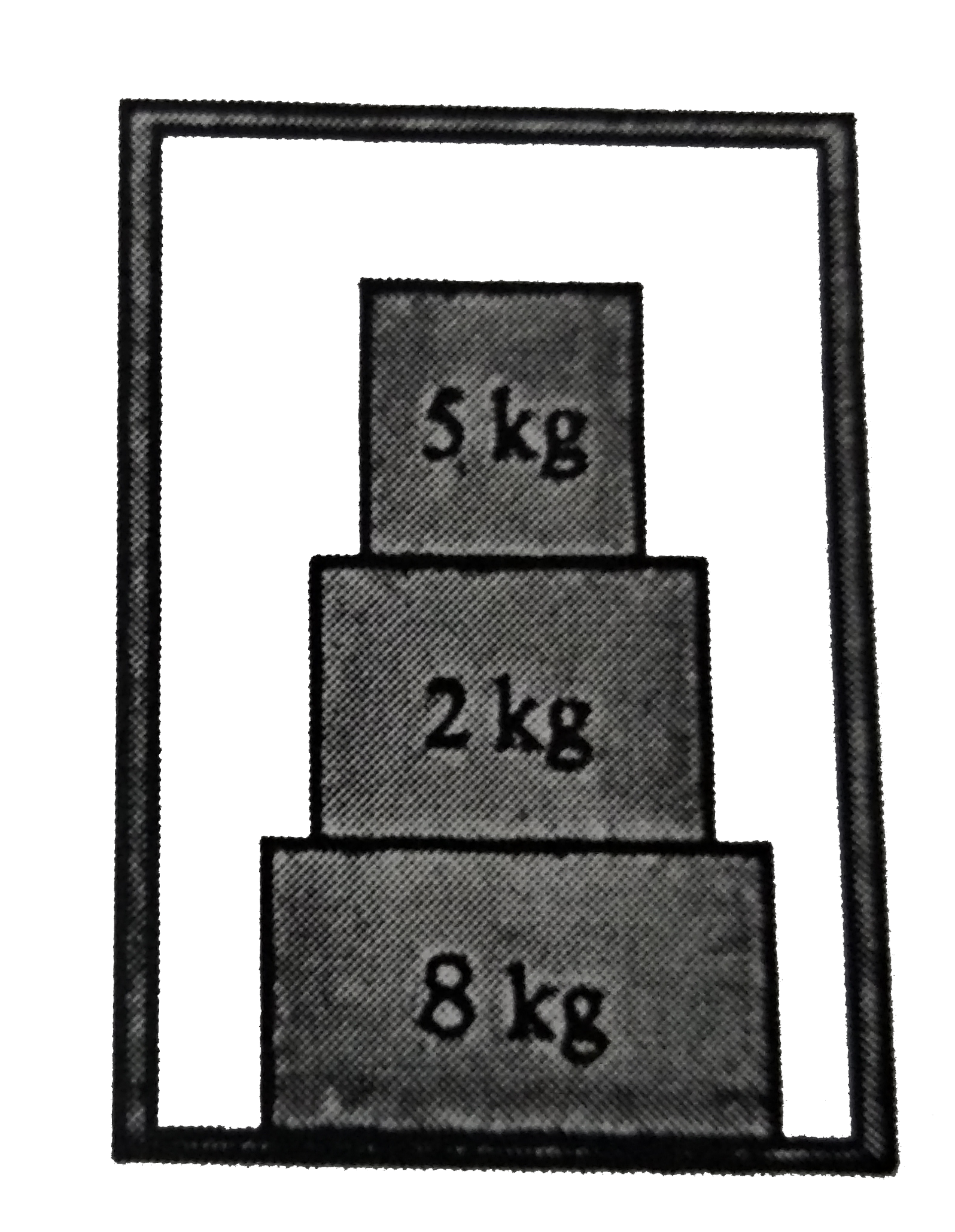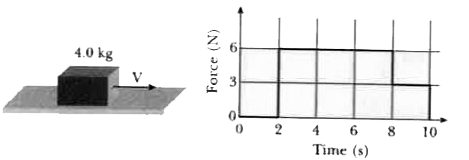The initial velocity of a 4.0-kg box is 11 m/s , due west. After the box slides 4.0 m horizontally, its speed is 1.5 m/s. Determine the magnitude and the direction of the non-conservative force acting on the box as it slides .
42N,duewest
31N,dueeast
83N,duewest
59N,dueeast
The correct Answer is:D
To solve the problem, we need to determine the magnitude and direction of the non-conservative force acting on the box as it slides. We can do this using the work-energy principle, which states that the work done by non-conservative forces is equal to the change in kinetic energy of the system.
1. Identify Given Values:
- Mass of the box, m=4.0kg
- Initial velocity, u=11m/s (due west)
- Final velocity, v=1.5m/s
- Distance slid, s=4.0m
2. Calculate Initial and Final Kinetic Energy:
- Initial kinetic energy, KEi=12mu2=12×4.0kg×(11m/s)2
- KEi=2.0×121=242J
- Final kinetic energy, KEf=12mv2=12×4.0kg×(1.5m/s)2
- KEf=2.0×2.25=4.5J
3. Calculate Change in Kinetic Energy:
- Change in kinetic energy, ΔKE=KEf−KEi=4.5J−242J=−237.5J
4. Relate Work Done to Change in Kinetic Energy:
- According to the work-energy principle, the work done by non-conservative forces is equal to the change in kinetic energy:
W=ΔKE
- Therefore, W=−237.5J
5. Calculate Work Done by Non-Conservative Forces:
- The work done can also be expressed as:
W=F⋅s
- Here, F is the magnitude of the non-conservative force and s=4.0m.
- Thus, we have:
F⋅4.0m=−237.5J
- Rearranging gives:
F=−237.5J4.0m=−59.375N
6. Determine the Direction of the Force:
- The negative sign indicates that the direction of the force is opposite to the direction of motion of the box (which is due west).
- Therefore, the non-conservative force is acting towards the east.
Final Answer:
- Magnitude of the Non-Conservative Force: 59.375N
- Direction of the Non-Conservative Force: Due east
- Mass of the box, m=4.0kg
- Initial velocity, u=11m/s (due west)
- Final velocity, v=1.5m/s
- Distance slid, s=4.0m
- Initial kinetic energy, KEi=12mu2=12×4.0kg×(11m/s)2
- KEi=2.0×121=242J
- KEf=2.0×2.25=4.5J
- Change in kinetic energy, ΔKE=KEf−KEi=4.5J−242J=−237.5J
- According to the work-energy principle, the work done by non-conservative forces is equal to the change in kinetic energy:
W=ΔKE
- Therefore, W=−237.5J
- The work done can also be expressed as:
W=F⋅s
- Here, F is the magnitude of the non-conservative force and s=4.0m.
- Thus, we have:
F⋅4.0m=−237.5J
- Rearranging gives:
F=−237.5J4.0m=−59.375N
- The negative sign indicates that the direction of the force is opposite to the direction of motion of the box (which is due west).
- Therefore, the non-conservative force is acting towards the east.
- Magnitude of the Non-Conservative Force: 59.375N
- Direction of the Non-Conservative Force: Due east
Topper's Solved these Questions
- BOOK - RESNICK AND HALLIDAYCHAPTER - WORK, POWER, AND ENERGYEXERCISE - PRACTICE QUESTIONS (More than one choice correct type)10videos
WORK, POWER, AND ENERGY
- BOOK - RESNICK AND HALLIDAYCHAPTER - WORK, POWER, AND ENERGYEXERCISE - PRACTICE QUESTIONS (Linked Comprehension)9videos
WORK, POWER, AND ENERGY
- BOOK - RESNICK AND HALLIDAYCHAPTER - WORK, POWER, AND ENERGYEXERCISE - PROBLEMS58videos
WORK, POWER, AND ENERGY
- BOOK - RESNICK AND HALLIDAYCHAPTER - WAVES-IEXERCISE - Practice Questions (Integer Type)4videos
WAVES-I
Similar Questions
A box of bananas weighing 40.0Nrests on a horizontal surface is 0.40 and the coefficient of kinetic friction is 0.20
a. If no horizontal force is applied to the box and the box is at rest , how large is the friction force excered on the box ?
b. What is the magnitude of the friction forces if a monkey applies a horizontal force of 6.0N to the box and the box is initial at rest?
c. What minimum horizontal force must the monkey apply to start the box in motion ?
d. What minimum horizontal force must the monkey apply to keep the box moving at constant velocity once it has been starts?
e. If the monkey applies a horizontal force of 18.0N What is the magnitude of the friction force and what is the box's acceleration ?View SolutionThe only force acting on a 2.0kg canister that is moving in an xy plane has a magnitude of 5.0 N. The canister initially has a velocity of 4.0 m/s in the positive x direction and some time later has a velocity of 6.0 m/s in the positive y direction . How much work is done on the canister by the 5.0 N force during this time ?
View Solution
Knowledge Check
- Question 1 - Select One
A 55-kg box is being pushed a distance of 7.0 m across the floor by a force →p whose magnitude is 150 N. The force →P is parallel to the displacement of the box. The coefficient of kinetic friction is 0.25. Determine the work done on the box by each of the four forces that act on the box. Be sure to include the proper plus or minus sign for the work done by each force. ( The four forces and the force P, the frictional force f, the normal force N, and the force due to gravity mg. )
AWpWfWNWmg1.0×103J−940J−3.8×103J3.8×103JBWpWfWNWmg1.0×103−940JzeroJzeroJCWpWfWNWmgzeroJ940J−3.8×103J3.8×103JDWpWfWNWmg−1.0×103JzeroJzeroJ−3.8×103J - Question 2 - Select One
A block of mass kg 5 is moving horizontally at a speed of 1.5m/s . A perpendicular force of 5 N acts on it for 4 sec. What will be the distance of the block from the point where the force started acting
A10 mB8 mC6 mD2 m - Question 3 - Select One
Three boxes are placed in a life. Wheen acceleration of the life is 4m/s2, the net force on the 8 kg box is closest to
 A80 NB48 NC40 ND32 N
A80 NB48 NC40 ND32 N
A 4.0-kg block slides along a frictionless surface with a constant speed of 5.0 m/s as shown. Two seconds after it begins sliding, a horizontal, time-dependent force is applied to the mass. The force is removed 8 s later. The graph shows how the force on the block varies with time.

What is the approximate speed of the block at t =11 s?View SolutionAt one instant a bicyclist is 30.0 m due east of a park's flagpole, going due south with a speed of 10.0 m/s. Then 30.0 s later, the cyclist is 40.0 m due north of the flagpole, going due east with a speed of 10.0 m/s. For the cyclist in this 30.0 s interval, what are the (a) magnitude and (b) direction of the displacement, the ( c) magnitude and (d) direction of the average velocity, and the (e) magnitude and (f) direction of the average acceleration?
View SolutionIn Fig. 6-42, a box of Cheerios (mass mc=1.0kg) and a box of Wheaties (mass mw=3.0kg) are accelerated across a horizontal surface by a horizontal force →F applied to the Cheerios box. The magnitude of the frictional force on the Cheerios box is 2.0 N, and the magnitude of the frictional force on the Wheaties box is 3.5 N. If the magnitude of →F is 12 N, what is the magnitude of the force on the Wheaties box from the Cheerios box?
 View Solution
View SolutionA heavy box is slid across a rough floor with an initial speed of 4 m/s. It stops moving after 8 seconds. If the average resisting force of friction is 10 N, the mass of the box (in kg) is
View SolutionA 100 kg cubical box lies on a floor. A child pushes horizontally at a top edge. What force magnitude puts the box on the verge of tipping over if there is sufficient friction between it and the floor to prevent sliding?
View Solution

